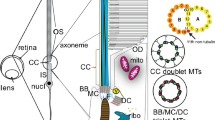Summary
The photoreceptors of the crayfish Procambarus clarkii undergo an extensive cycle of turnover in the late afternoon. Quantitative light and electron microscopy reveal a sharp increase in the fractional volume (i.e., density) of reflecting-pigment-cell granules and vacuoles shortly following late-afternoon photoreceptor turnover. The reflecting pigment cells (RPCs), which permanently reside within the crayfish retina, are shown to serve much the same function as the vertebrate pigment epithelium. The RPCs phagocytose partially digested photoreceptive microvilli and the ingested debris is degraded further into the granules and vacuoles which characterize these cells. Phagosome degradation appears to be mediated by Golgi complexes. Acid phosphatase appears to be involved in the initial rhabdom breakdown but not in the final reduction of RPC granules.
Similar content being viewed by others
References
Anderson DH, Fisher SK (1976) The photoreceptors of diurnal squirrels: disc shedding and protein renewal. J Ultrastruct Res 55:119–141
Anderson DH, Fisher SK, Steinberg RH (1978) Mammalian cones disc shedding, phagocytosis and renewal. Invest Opthal 17:117–133
Barka T, Anderson PJ (1962) Histochemical methods for acid phosphatase using hexazonium pararosanilin as coupler. J Histochem Cytochem 10:741–753
Blest AD (1980) Photoreceptor membrane turnover in arthropods: comparative studies of breakdown processes and their implications. In: Williams TP, Baker BN (eds) The effects of constant light on visual processes. Plenum, New York
Blest AD, Maples J (1979) Exocytotic shedding and glial uptake of photoreceptor membrane by a salticid spider. Proc R Soc Lond B 204:105–112
Blest AD, Stowe S, Price GD (1980) The sources of acid hydrolases for photoreceptor membrane degradation in a grapsid crab. Cell Tissue Res 205:229–244
Braekevelt CR (1980a) Fine structure of the retinal pigment epithelium in the mud minnow (Umbra limi). Can J Zool 58:258–265
Braekevelt CR (1980b) Fine structure of the retinal epithelium and tapetum lucidum in the giant danio (Danio malabaricus) (Teleost). Anat Embryol 158:317–328
Chamberlain SC, Barlow RB (1982) Structure of Limulus rhabdom in light and darkness: Rhabdom turnover in the natural state. Soc Neurosci Abstr 8: 687
Chamberlain SC, Barlow RB (1984) Transient membrane shedding in Limulus photoreceptors: Control mechanisms under natural lighting. J Neurosci 4:2792–2810
Couet HG de, Blest AD (1982) The retinal acid phosphatase of a crab, Leptograpsus: characterization and relation to the cyclical turnover of photoreceptor membrane. J Comp Physiol 149:353–362
Debaisieux P (1942) Accomodation à la lumière des yeux de Décapodes. Ann Soc R Zool Belg 73: 51–53
Debaisieux P (1944) Les yeux des Crustacés. La Cellule 50:1–122
Eguchi E, Waterman TH (1967) Changes in retinal fine structure in the crab Libinia by light and dark adaptation. Z Zellforsch 79:209–229
Eguchi E, Waterman TH (1976) Freeze-etch and histochemical evidence for cycling in crayfish membrane. Cell Tissue Res 169:419–434
Hafner GS, Bok D (1977) The distribution of 3H-leucine labelled protein in the retinula cells of the crayfish. J Comp Neurol 174:397–416
Hafner GS, Hammond-Soltis G, Tokarski T (1980) Diurnal changes of lysosome-related bodies in the crayfish photoreceptor cells. Cell Tissue Res 206:319–332
Karnovsky MJ (1965) A formaldehyde-glutaraldehyde fixative of high osmolality for use in electron microscopy. J Cell Biol 27:137A
Lowe ER (1976) Light, and photoreceptor degeneration in the Norway lobster, Nephrops norvegicus (L.). Proc R Soc Lond B 193:31–44
Novikoff AB, Quintana N, Villaverde H, Forschirm (1966) Nucleoside phosphatase and cholinesterase actinities in dorsal root ganglia and peripheral nerve. J Cell Biol 29:525–544
O'Day WT, Young RW (1978) Rhythmic daily shedding of outersegment membranes by visual cells in the goldfish. J Cell Biol 76:593–604
Piekos WB, Waterman TH (1983) Nocturnal rhabdom cycling and retinal hemocyte functions in crayfish (Procambarus) compound eyes. I. Light microscopy. J Exp Zool 225:209–217
Stowe S (1980) Rapid synthesis of photoreceptor membrane and assembly of new microvilli in a crab at dusk. Cell Tissue Res 211:419–440
Stowe S (1983) Phagocytosis of rhabdomeral membrane by crab photoreceptors (Leptograpsus variegatus). Cell Tissue Res 234:463–467
Waterman TH, Piekos WB (1981) Light and time correlated migration of invasive hemocytes in the crayfish compound eye. J Exp Zool 217:1–14
Waterman TH, Piekos WB (1983) Nocturnal rhabdom cycling and retinal hemocyte functions in crayfish (Procambarus) compound eyes. II. Transmission electron microscopy and acid phosphatase localizations. J Exp Zool 225:219–231
White RH (1964) The effect of light upon the ultrastructure of the mosquito eye. Am Zool 4:433
White RH (1967) The effect of light and light deprivation upon the structure of the larval mosquito eye. II. The rhabdom. J Exp Zool 166:405–425
White RH (1968) The effect of light and light deprivation upon the structure of the larval mosquito eye. III. Multivesicular bodies and protein uptake. J Exp Zool 169:261–268
White RH, Gifford D, Michaud NH (1980) Turnover of photoreceptor membrane in the larval mosquito ocellus: rhabdomeric coated vesicles and organelles of the vacuolar system. In: Williams TP, Baker BN (eds) The effects of constant light on visual processes. Plenum, New York
Williams DS (1980) Ca++-induced structural changes in photoreceptor microvilli of Diptera. Cell Tissue Res 206:225–232
Williams DS, Blest AD (1980) Extracellular shedding of photoreceptor membrane in the open rhabdom of a tipulid fly. Cell Tissue Res 205:423–438
Williams MA (1977) Quantitative methods in biology. In: Glauert AM (ed) Practical methods in electron microscopy, Vol 6. North-Holland Publishing, Amsterdam
Young RW (1978) Visual cells, daily rhythms and vision research. Vision Res 18:573–578
Zar JH (1974) Biostatistical analysis. Prentice-Hall, Englewood Cliffs, N.J.
Author information
Authors and Affiliations
Rights and permissions
About this article
Cite this article
Barry Piekos, W. The role of reflecting pigment cells in the turnover of crayfish photoreceptors. Cell Tissue Res. 244, 645–654 (1986). https://doi.org/10.1007/BF00212545
Accepted:
Issue Date:
DOI: https://doi.org/10.1007/BF00212545




